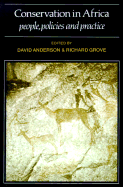Book contents
- Frontmatter
- Contents
- Preface
- List of contributors
- Introduction: The scramble for Eden: past, present and future in African conservation
- Part One Conservation ideologies in Africa
- Part Two Wildlife, Parks and Pastoralist
- Part Three Conservation priorities and rural communities
- Part Four Consequences for conservation and development
- Introduction
- 13 The political reality of conservation in Nigeria
- 14 Settlement, pastoralism and the commons: the ideology and practice of irrigation development in Northern Kenya
- 15 Approaches to water resource development, Sokoto Valley, Nigeria: the problem of sustainability
- 16 State policy and famine in the Awash Valley of Ethiopia: the lessons for conservation
- Index
16 - State policy and famine in the Awash Valley of Ethiopia: the lessons for conservation
Published online by Cambridge University Press: 04 April 2011
- Frontmatter
- Contents
- Preface
- List of contributors
- Introduction: The scramble for Eden: past, present and future in African conservation
- Part One Conservation ideologies in Africa
- Part Two Wildlife, Parks and Pastoralist
- Part Three Conservation priorities and rural communities
- Part Four Consequences for conservation and development
- Introduction
- 13 The political reality of conservation in Nigeria
- 14 Settlement, pastoralism and the commons: the ideology and practice of irrigation development in Northern Kenya
- 15 Approaches to water resource development, Sokoto Valley, Nigeria: the problem of sustainability
- 16 State policy and famine in the Awash Valley of Ethiopia: the lessons for conservation
- Index
Summary
The increasing incidence of widespread famine among the peoples of the Sahel and northeast Africa has raised the issue of the responsibility of the state in matters of land-use planning in the most acute way possible. Some observers have placed the blame for the extent of the human disaster of famine on processes of environmental and climatic deterioration and population increase (e.g. Milas & Asrat, 1985). Rainfall decline since 1971 in many parts of the Sahel has made this analysis predictable. Moreover, the facts of environmental deterioration, especially in the form of deforestation, have been convincing, as far as the very weak statistical material allows (Grove, 1986). Since the Second World War Ethiopia has lost up to 70 per cent of its forest cover and the increased incidence of soil erosion has reflected this (Roundy, 1985). During the recent famine the image of an incompetent peasantry struggling to produce food by ineffective and destructive methods from a devastated environment has been assiduously cultivated by outside commentators. This image of incompetence has also been attached to a government which has been castigated for its failure over many years to provide effective and durable agricultural assistance in the famine-prone areas, as well as for its inequitable treatment of the victims of famine. Ignorant peasants and incompetent government therefore make up the popular image of Ethiopia's recent plight.
- Type
- Chapter
- Information
- Conservation in AfricaPeoples, Policies and Practice, pp. 327 - 344Publisher: Cambridge University PressPrint publication year: 1988
- 2
- Cited by



